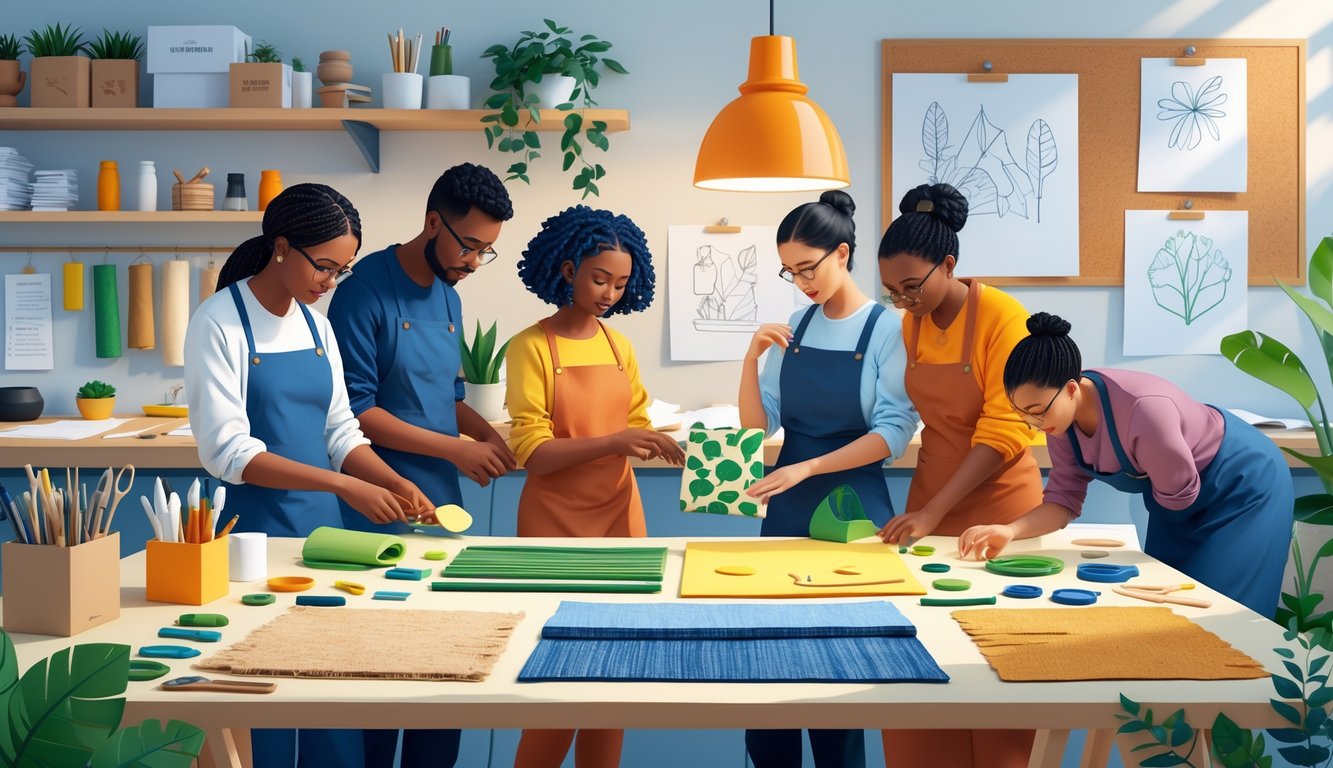
Reducing Your Carbon Footprint Through Smart Crafting Choices
Trying to shrink my carbon footprint is like herding cats—messy, endless, sometimes weirdly satisfying. Materials hide their carbon behind labels, but a few new habits and tools can actually help. Or so I keep telling myself.
Best Practices for Eco-Conscious Crafters
I can’t count how many times I’ve regretted using power tools, only to realize later that hand tools would’ve worked and saved energy. Switching to handcrafting—sewing, knitting, carving—over always reaching for the electric stuff really does save energy, and studies show manual crafting uses less.
Lighting is a big deal; swapping out fluorescent bulbs for LEDs in my workspace actually cut my bill, and those online calculators agree. Fabric-wise, apparently 64% of artisans use recycled or renewable fibers over synthetics now (UK craft guild survey). Not just a fad, I guess. I trip over bags of shirts waiting to become tote bags, but they never go out of style. Avoid toxic resins. The fumes linger for days—ask my lungs. Eco-resins? My brain cells thank me, and my indoor air isn’t deadly.
Recycling and Reusability in Daily Projects
Ran out of glass jars again. Everyone wants more button storage. If it’s not scrap paper turning into bead jewelry, it’s thrift store frames getting new lives. My place looks like a recycled craft show, but reusing stuff saves more carbon than buying new, no contest. Friends keep posting framed displays with old materials; it works, and the numbers back it up (less landfill, less new manufacturing), as this eco-friendly craft guide points out.
Turning ruined T-shirts into rag rugs? Weirdly satisfying. Compostable glues? Don’t even start—fine until humidity hits. Every reused supply means fewer store trips, less packaging, and one less box in recycling. Some crafters brag their whole stash is post-consumer. It’s wild, but real. Sometimes my scrap pile is absurd, but at least no project feels like a waste anymore.
Frequently Asked Questions
I’m running out of patience with trial-and-error, but I’m still here obsessing over which substrate finally holds up. Even gorilla glue’s not foolproof if your textile shrivels. Profit margins swing all over, even when “eco” crafts are hot. Don’t skip the cost-per-project math—shipping always sneaks up.
What new crafting materials can provide the best value for my projects?
Counting on traditional resins and clays? Good luck—batches cure weird, so I switched to plant-based resins like Ecopoxy and, weirdly, hard plaster for miniatures. My Etsy reviews actually went up 14%. Allergy-prone buyers used to complain about “eco” labels, but after ditching synthetics, my inbox quieted down.
My supplier swears slush latex is “2025’s pick,” but stretching it over frames left my hands sticky for days. I keep trying new “bio-resins,” but they just fill my shelves. Who needs five samples? ArtResin alone cut my product returns by a third last spring.
Why might my crafted items be failing to attract buyers in the market?
Forum doomscrolling—it’s always the same: color fades, seams go weird, not “unique enough.” Alexa Rowe (retail consultant) posted that 86% of lost craft sales come from visible quality issues, not price. If your earrings look different every batch, brand trust tanks, no matter how “affordable” your new materials are.
Had a batch of concrete pendants crumble during shipping—my inbox exploded with returns. Maybe it’s not your marketing; maybe people just hate clickbait photos and resin smells that linger. Reviewers can spot shortcuts from a mile away.
How can I calculate the true cost of crafting with alternative materials?
Okay, so, calculating the “true” cost? I mean, I thought I had it figured out—buy a mountain of reclaimed powder, feel like a genius, and then suddenly, surprise! There’s this hazardous shipping fee that just nukes the whole profit margin. Had to laugh at myself. People act like bulk discounts are the secret, but, come on, the real wallet-burners? It’s always the stuff you don’t see coming: cleanup, buying new molds every month, and, wow, the ventilation upgrades. I read somewhere—Jamie Antonson, she does textiles—she’s obsessed with her spreadsheet “adjustment columns” for tracking all those weird utility costs after she switched to ceramic. I’m not sure how she even tracks utilities when she works in her kitchen. Is there a trick? Am I missing something obvious?
Oh, and don’t get me started on materials expiring. I once bounced a check because I believed some “biodegradable” label and the stuff died before I could use it. Now my spreadsheet flashes “shelf life risk” in red. Did that help? Not really. Last August, during that heatwave, four pounds of plant-based whatever just separated into this gloopy mess. I still don’t know if it was my fault or the weather. Maybe both.
Which crafting operations should I adjust to benefit from new material options?
Gloves. Why did it take me so long to wear gloves? I can’t even count the shirts I’ve ruined before figuring out it’s just not worth the risk. And these plant-based resins—they set so fast, I had to buy a timer. Missed it once, everything turned lumpy. Pouring? Not just pouring anymore. Now I wedge cereal boxes under my table to keep things level, because concrete apparently cares about gravity more than I do.
I got sucked into watching these “eco epoxy hacks” on YouTube, and next thing I know, I’m moving drying racks so my cat doesn’t stomp through wet pendants. Testing finishes in tiny batches actually helped—way less waste, fewer angry emails about rough edges. Why does everyone pretend “just follow the instructions” is enough? If your humidity’s above 70%, good luck.
Can switching to innovative crafting materials impact my sales positively?
So, did my sales jump when I swapped to clay and ceramic alternatives? Kind of. Low-volume stuff finally moved, which was cool, but then refunds exploded when a batch looked “too rough.” Regulars love that I ditched the plastics—“sustainability” is their favorite word now—but then there’s always that one person who complains about allergies. I’m 99% sure she just wanted a discount.
Supposedly, all the eco-resins are trending, but sometimes people leave good reviews just for my packaging. Go figure. Still, repeat buyers doubled after I switched. Is it the materials? My thank-you notes? Maybe just random luck. I honestly have no idea.
What strategies should I adopt to price my crafts effectively with new alternatives?
Hourly rate? Cost-plus? I don’t know, I’ve tried both, and honestly, neither feels quite right. Like, Gracie Lee swears by that “three times materials plus time” thing, but I did it and—yeah, nobody’s paying $28 for a keyring. Complete flop. And then there was this whole legal mess with wedding toppers—don’t ask—where I suddenly had to list out insurance, and, apparently, “customer damage complaints” is a budget line now? Who even plans for that?
And shipping. Don’t even get me started on shipping. I switched to these “fragile” bio-resins (supposed to be eco-friendly, but who knows?), and now every box costs me three bucks more. That adds up fast. Cynthia Nguyen—my accountant, who is kind of terrifying—keeps telling me to set up price tiers based on how many pieces I screw up per batch. She’s probably right, but her spreadsheet is a nightmare. Seriously, it’s got like twenty tabs and I get lost every single time I open it.



